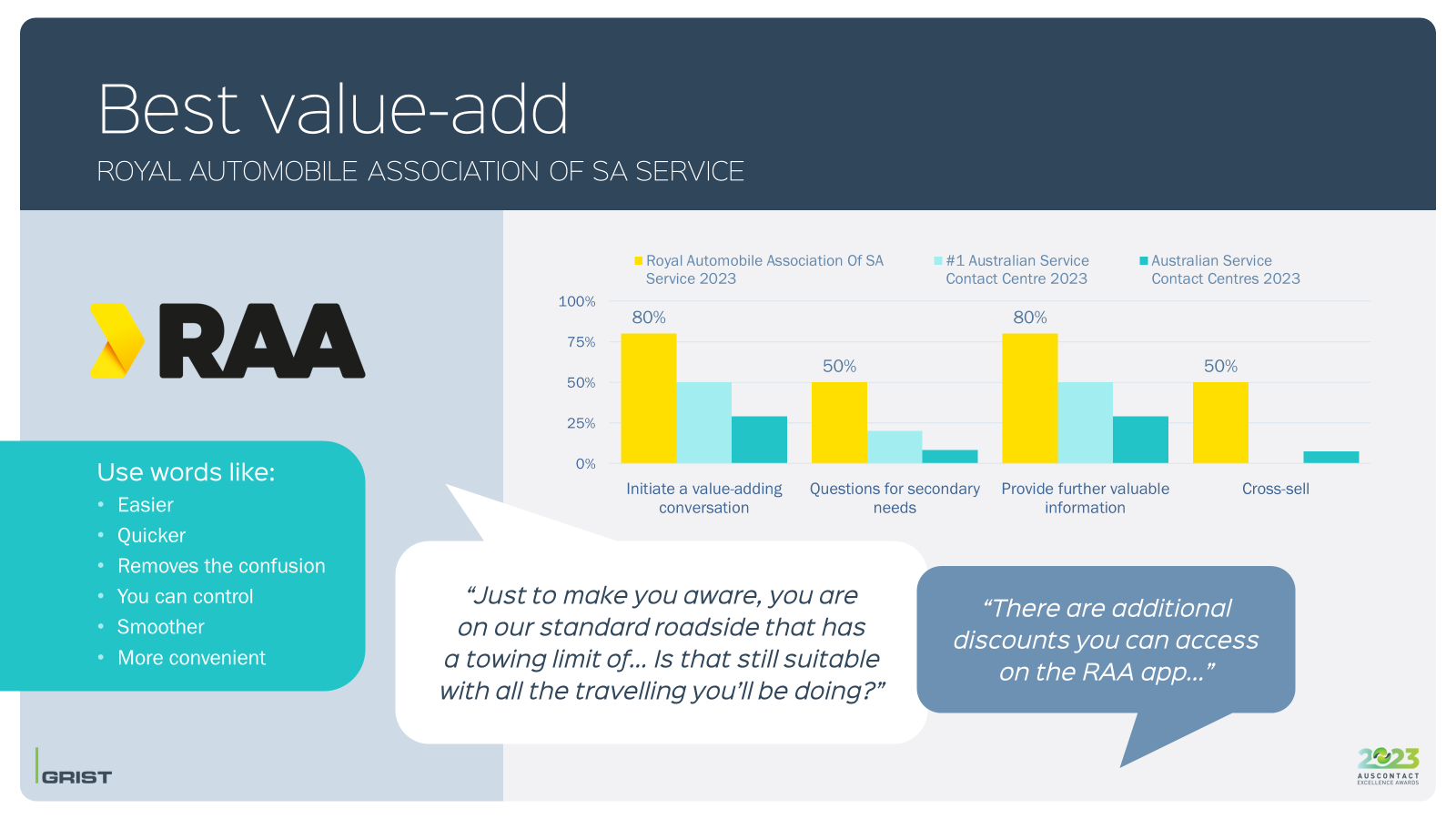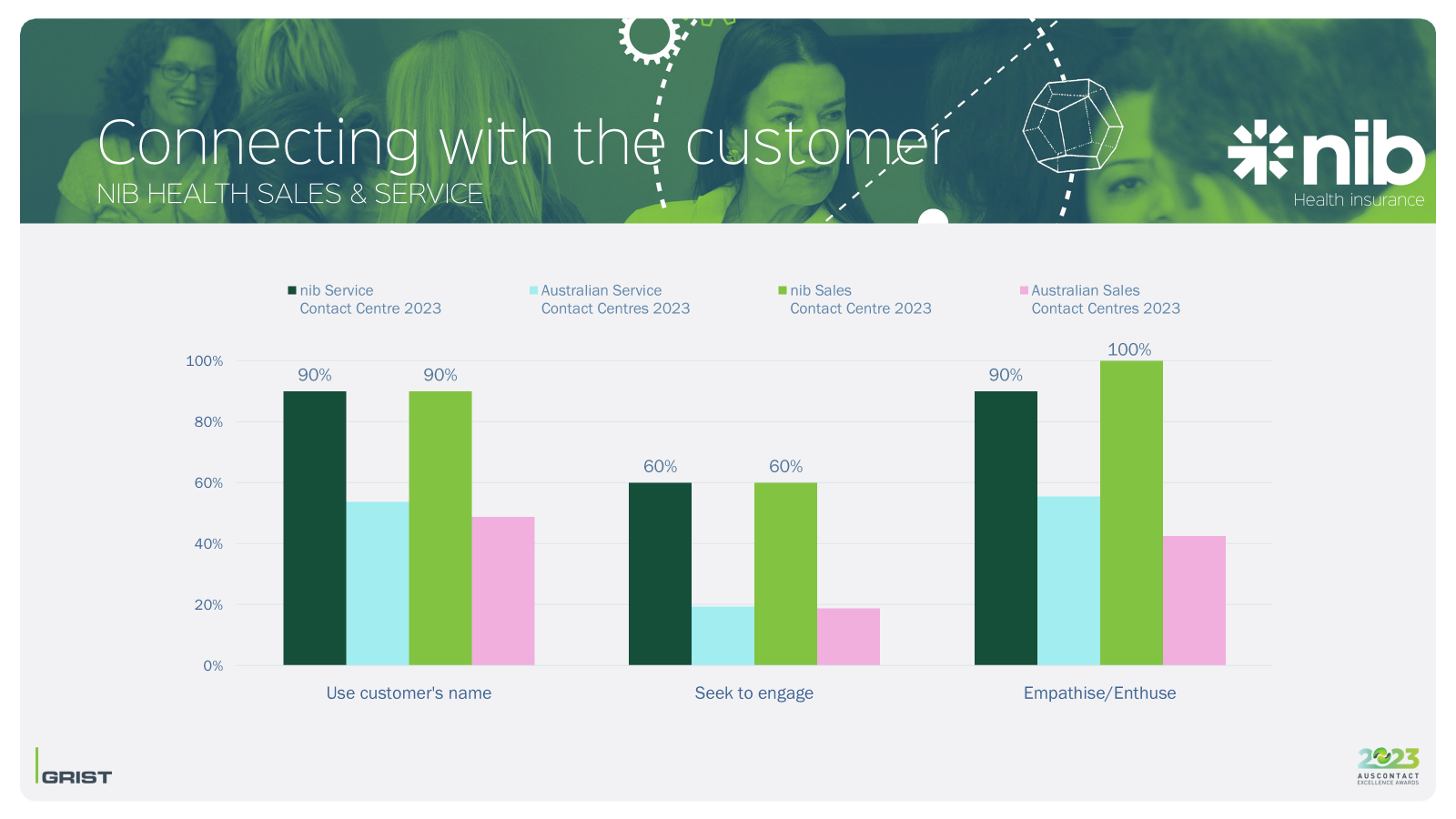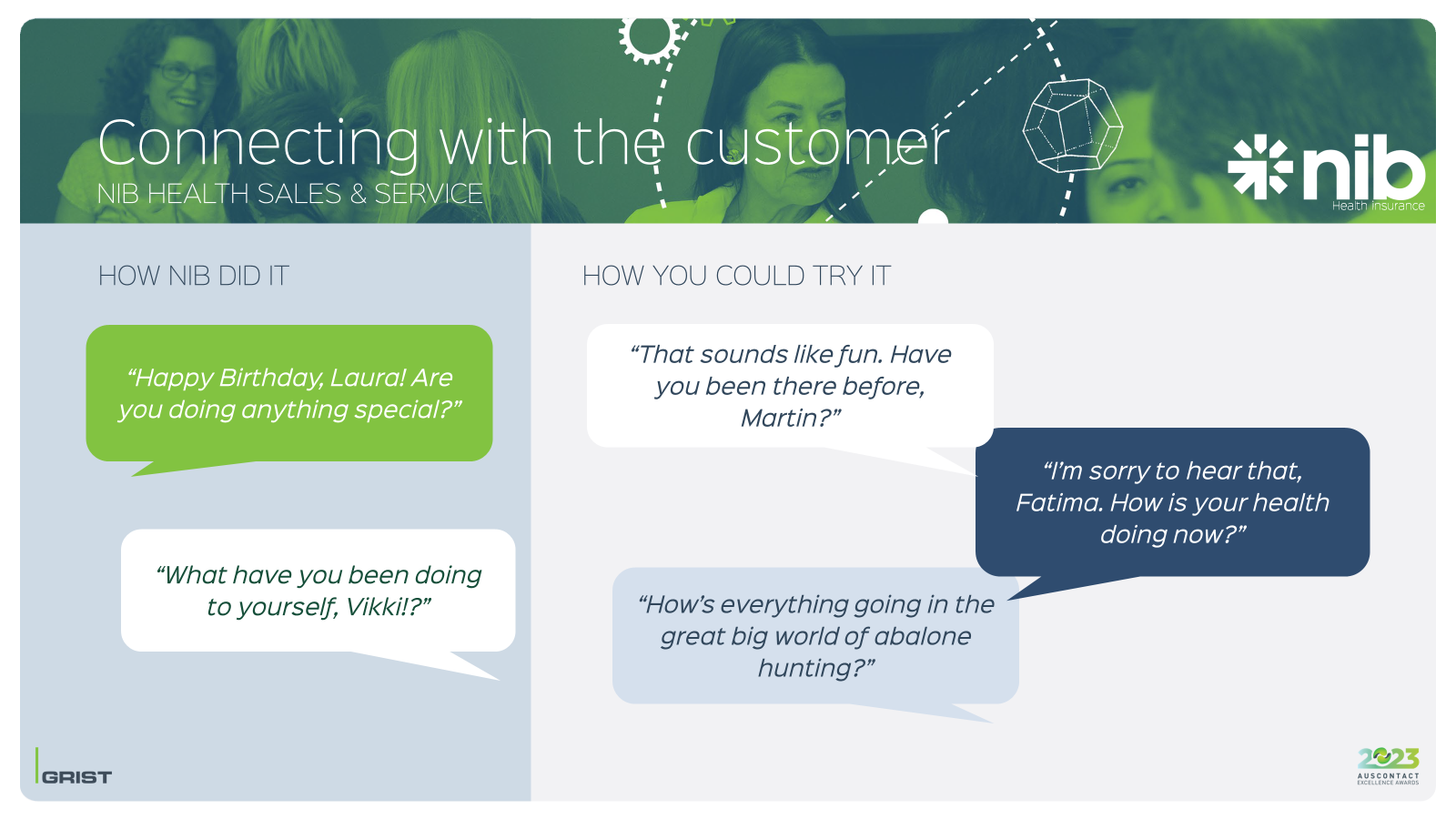Insights from the 2023 Auscontact & GRIST Service Excellence and Sales Excellence Awards
At the 2023 Auscontact National Awards, GRIST assessed and presented two excellence awards to recognise customer-centric behaviours demonstrated by consultants in service and sales contact centres. These two awards were based on evaluations of real customer calls by our expert behavioural analysts.
We ran a webinar in November where we unpacked all the insights – which you can watch here – but have also summarised some of our key findings and overall trends below.
How does this kind of assessment work?
We assess customer calls using a micro-behavioural conversation framework. Below you can see a simple framework that gives structure to any sales or service conversation. You may be familiar with this kind of structure.
When we assess calls, we go one level deeper. Under each of these phases we assess a bunch of ‘micro-behaviours.’ These micro-behaviours target the key moments that matter for your customers – the things that when done well, will turn an ordinary interaction into an exceptional one.
What are micro-behaviours? They are what their name suggest: they’re tiny behaviours that you can hear or see – they’re either there or they’re not. This allows for objective and transparent measurement that gives insight into what is happening in a conversation.
They’re not a script – as you’ll see when we look at some examples of key micro-behaviours, this kind of framework allows for self-expression and flexibility: we want consultants to be human, and we want them to enjoy the conversation just as much as the customer!
This micro-behavioural assessment means we can assess a mix of calls across diverse areas of industry. We have over 70 micro-behaviours we look for, and there are many core similarities between sales and services micro-behaviours. But, there are some crucial differences that make a big difference to a customer and require different skills from the consultant.
There’s a mix of both service and sales data quite a bit – to keep it clear we have used blue for service and pink for sales. And while you may have a foot in one camp over the other, most of the behaviours are applicable to all contact centre teams.
Service Excellence
Let’s start with the Service Excellence Award. First up, a huge congratulations to our finalists – it was fantastic to see you all at the awards! nib Group Health took out the top spot; with Synergy and nib Group Travel tying for second spot. Concentrix was third, followed by Teachers Mutual Bank and NobleOak life insurance
Let’s look closer at our Service Excellence data for 2023
Below is all the Service Excellence Award data as a frequency graph; which means the percentage on the y-axis is how often our assessors observed the behaviours along the x-axis. For example: 100% = the behaviour was observed on every call, 0% = the behaviour wasn’t observed on any call.
The behaviours are ordered in a way that represents the customer’s journey through a conversation with a service contact centre, beginning with Engage, Discovery then moving to Solution and Close. We call this the Customer Journey Graph.
The blue bars are the average of all the submitted recordings for the Service Excellence award this year, the darker blue line is our #1 performing Australian Service Contact Centre for 2023, nib Health
As you can see, there are some behaviours the #1 contact centre has performed more consistently, and others like Current situation questions, Providing a specific solution & Keep customer informed show strong performance across the board.
Service Excellence 2023 trends:
All Service contact centres consistently asked customers about their situation.
Asking questions to understand a customer's current situation or how they use products, equips the consultant with the information they require to provide a specific solution.
The other trend, 99% of customers leaving with a single tailored solution.
Providing a tailored solution will increase the probability of the customer agreeing with what's been offered as a solution and them leaving satisfied.
These combined micro-behaviours increase the likelihood of first call resolution.
We also saw the ‘Keep customer informed’ micro-behaviour scoring highly across the board. You can think about this behaviour as the equivalent to body language. As customers can’t see what an agent is doing, the agent should give clear verbal cues to keep the customer in the loop. No-one wants to be left hanging in silence!
Everyone demonstrated these micro-behaviours pretty consistently, so these examples should look familiar
Sales Excellence
For the Sales Excellence award for 2023, nib Group Health took out the top spot again, followed closely by NobleOak life insurance in 2nd and ANZ Everyday Banking in 3rd. nib Group Travel took fourth, with Allianz insurance just behind them.
The pink bars are the average of all the submitted recordings for the Sales Excellence award this year, the darker pink line is our #1 performing Australian Sales Contact Centre for 2023, nib Health
As with the Service customer journey, there are some behaviours the #1 contact centre has performed more consistently, and others that show an overall strong performance, again Providing a specific solution, Explaining Features and Asking for the sale.
Sales Excellence 2023 takeaways:
Just like the Service customers, 99% of sales customers left with a specific sales solution
With the majority, 71%, highlighting it’s features
This thorough approach to solving the customer’s requirements gave 75% of consultants the confidence to ask the customer to proceed with the sales process
As far as the customer is concerned, providing a clear, specific solution is the most important part of the conversation. This is the part that the customer has been waiting for and is expecting. By consistently providing a specific solution and explaining its features, customer expectations are met giving consultants the confidence to ask for the sale.
The 3rd example above warrants a specific call out: “Would you like me to get that arranged for you now?” You can hear how this offer of sale is clear, direct and requires a Yes or No response which helps the decision-making process for the customer. It’s customer-centric and it’s not pushy.
Best Practice awards
These awards are examples identified by assessors as stand-out performances by teams other than our #1 that deserved to be celebrated.
Best Value Add contact centre - RAA (Royal Automotive Association of South Australia) Service
RAA excelled in helping their customers by providing unexpected value and/or connecting them with additional help. Everyone loves extra value and it certainly doesn’t have to be big to make an impression. RAA showed an ability to pick up on a trigger, or snippet, whether something a customer said with purpose or a throwaway comment, and used it to provide their customers further valuable information.
Using words like easier, quicker, smoother are great ways to start introducing this into customer conversations
The examples illustrate how this can be performed either in response to a customer trigger (example 1) or more generically (example 2).
Best Practice: Setting the Scene - ANZ Sales
ANZ gave their customers a clear indication upfront of what would happen on the call. This transparency in the process helped engender involvement and maintain trust and confidence, so when asked to give their buy-in, customers responded with a confident, Yes!
The ‘introduce process’ micro-behaviour is a powerful way to set up a call as it;
Sets expectations of what’s to come to reduce confusion for the customer
Creates a sense of ease by navigating the customer through the conversation, and
Has shown to reduce AHT
The natural buddy for the ‘introduce process’ micro-behaviour is the small but mighty ‘seek permission to proceed’. This micro-behaviour is an easy behaviour to roll into after setting expectations, puts the customer in control by asking for their buy-in and is a simple way to build rapport-building to start the conversation on the right foot.
For those who love habit-stacking, these two behaviours are for you – you can see how simply one anchors to the other. ‘Seek permission to proceed’ can be done at multiple points in a conversation, but it really sings here at the start.
nib Group Health – What separates the best from the rest
Connecting with the customer
The first few moments with a customer set the tone for the remainder of the conversation influencing whether it is successful or not. nib Health’s sales and service consultants have an ability to connect and interact with customers on a personal level which demonstrates a genuine interest in the individuals – they’re raising customer’s expectations for this type of interaction.
When we think about the future for contact centres, the skill of connecting and deftly steering a conversation will become even more essential for agents to handle the increasingly complex customer enquiries that will be coming their way.
Below are some examples from nib, but you’ll see they’re very applicable across all industries.
Mandatory security checks can be tedious, but if you’re clever, you can use them ripe fruit for engagement. Obtaining and using a customer’s name is an easy one – ask how they like to be addressed, make a note and use it throughout your chat! Birth date is also a good one – there’s a 1 in 6 chance your customer is going to have a birthday within a month of your conversation – so use that to Enthuse and Engage. And then there are all the organic opportunities that come up along the way, but they take a bit more practice.
Understanding WHY
When customers call, they anticipate and hope for questions. This is where they get to talk about themselves, share what’s going on, and what they’re thinking. In return, there is an expectation that they will be helped. nib Group Health Sales’s desire to understand the enquiry through questioning demonstrates curiosity and interest while ensuring they provide the right solution. nib sales agents go further than ‘what can I do for you’ to ‘what prompted you to contact us today?’. It may sound like a small distinction, but the nuance in the second question means the information you’ll get from the customer will likely be much richer and get much closer to the heart of what they need.
Understanding and expanding on the why potentially opens up the conversation to address much broader needs from both a sales perspective and a value-added one. Knowing ‘why’ is also important to understand how a customer is interacting with your products and services, what their pain points might be and what they look for in a provider. This can help agents anticipate features and benefits that may be of value to a customer early and flag any possible objections that might come up further in the conversation. When looking for customer loyalty and retention, identifying, expanding on and clearly understanding the ‘why’ becomes paramount.
nib sales are exceptional at understanding the why.
First call resolution
A lot can be done to make life easier, simpler and to empower customers. They aren’t experts when it comes to what is on offer but you are! The key behaviours Education, Explaining next steps, Keeping customer informed, and Checking understanding, have been seen to increase both the likelihood of first-call resolution and customer satisfaction.
nib Health service agents routinely identify opportunities to provide more thorough solutions for their customers ensuring they receive maximum value and benefit from product/services.
Here’s how nib did it; and what it could sound like for you














